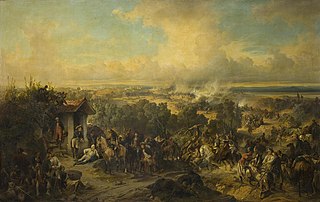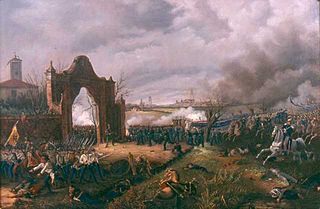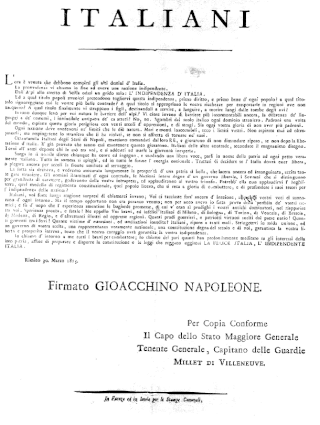
The Battle of Marengo was fought on 14 June 1800 between French forces under the First Consul Napoleon Bonaparte and Austrian forces near the city of Alessandria, in Piedmont, Italy. Near the end of the day, the French overcame General Michael von Melas' surprise attack, drove the Austrians out of Italy and consolidated Bonaparte's political position in Paris as First Consul of France in the wake of his coup d'état the previous November.

The Battle of (the) Trebbia was fought near the rivers of Tidone, Trebbia, and Nure in northern Italy between the joint Russian and Habsburg army under Alexander Suvorov and the Republican French army of Étienne-Jacques-Joseph-Alexandre Macdonald. Though French forces were moderately more numerous, the Austro-Russians severely defeated the French, sustaining about 5,500 casualties while inflicting losses of 16,500 on their enemies. The War of the Second Coalition engagement occurred west of Piacenza, a city located 70 kilometres (43 mi) southeast of Milan.

The War of the Third Coalition was a European conflict lasting from 1805 to 1806 and was the first conflict of the Napoleonic Wars. During the war, France and its client states under Napoleon I and its ally Spain opposed an alliance, the Third Coalition, which was made up of the United Kingdom, the Austrian Empire, the Russian Empire, Naples, Sicily, and Sweden. Prussia remained neutral during the war.

The Neapolitan War, also known as the Austro-Neapolitan War, was a conflict between the Napoleonic Kingdom of Naples and the Austrian Empire. It started on 15 March 1815, when King Joachim Murat declared war on Austria, and ended on 20 May 1815, with the signing of the Treaty of Casalanza. The war occurred during the Hundred Days between Napoleon's return from exile and before he left Paris to be decisively defeated at the Battle of Waterloo. The war was triggered by a pro-Napoleon uprising in Naples and ended with a decisive Austrian victory at the Battle of Tolentino, after which Bourbon monarch Ferdinand IV was reinstated as King of Naples and Sicily. However, the intervention by Austria caused resentment in Italy, which further spurred on the drive towards Italian unification.

Guglielmo Pepe was an Italian general and patriot. He was brother to Florestano Pepe and cousin to Gabriele Pepe. He was married to Mary Ann Coventry, a Scottish woman who was the widow of John Borthwick Gilchrist, linguist and surgeon to the East India Company.

The Battle of Tolentino was fought from 2–3 May 1815 near Tolentino, Kingdom of Naples in what is now Marche, Italy: it was the decisive battle in the Neapolitan War, fought by the Napoleonic King of Naples Joachim Murat to keep the throne after the Congress of Vienna. The battle occurred during the Hundred Days following Napoleon's return from exile and, like the Battle of Waterloo, resulted in a decisive victory for the Seventh Coalition, leading to the restoration of the previous Bourbon king, Ferdinand I.

The Italian campaigns of the French Revolutionary Wars (1792–1801) were a series of conflicts fought principally in Northern Italy between the French Revolutionary Army and a Coalition of Austria, Russia, Piedmont-Sardinia, and a number of other Italian states.

The First Italian War of Independence, part of the Italian Unification (Risorgimento), was fought by the Kingdom of Sardinia (Piedmont) and Italian volunteers against the Austrian Empire and other conservative states from 23 March 1848 to 22 August 1849 in the Italian Peninsula.
The Battle of Modena may refer to:
The Battle of Carpi took place during the Neapolitan War between a brigade of Neapolitan soldiers under the command of Guglielmo Pepe and an Austrian force under the command of Baron Frimont. The battle took place in the town of Carpi and resulted in an Austrian victory, with the Neapolitans being driven from the town.

The Battle of Casaglia was a part of the Neapolitan War. An Austrian force under the command of Johann Friedrich von Mohr engaged a Neapolitan force under their commander, Joachim Murat. The battle took place around the village of Casaglia, seven miles northwest of Ferrara, and resulted in the Austrians recapturing the village from Murat.
The Battle of Occhiobello was fought on 8 April – 9 April 1815 and was the turning point of the Neapolitan War. Joachim Murat, King of Naples was repulsed by an Austrian force under the command of Johann Frimont whilst trying to cross the bridge over the Po River at Occhiobello. Following the battle, the Austrians would not lose an engagement for the remainder of the war.

Adam Albert, Count von Neipperg was an Austrian general and statesman. He was the son of a diplomat famous for inventing a letter-copying machine, and the grandson of Count Wilhelm Reinhard von Neipperg. His second wife, Empress Marie-Louise, was the widow of Napoleon and a daughter of Francis II, the last Holy Roman Emperor and founding Emperor of the Austrian Empire.
The Battle of Scapezzano was a short engagement during the Neapolitan War on 1 May 1815 between an Austrian corps under Adam Albert von Neipperg and a Neapolitan division under Michele Carrascosa.

The Battle of Castel di Sangro was a minor battle in the Neapolitan War that took place on 13 May 1815 in the town of Castel di Sangro in central Italy. The battle resulted in the Neapolitan force being routed.

The Battle of San Germano was the final battle in the Neapolitan War between an Austrian force commanded by Laval Nugent von Westmeath and the King of Naples, Joachim Murat. The battle started on 15 May 1815 and ended on 17 May, after the remaining Neapolitan force was routed at Mignano.

The Battle of Campo Santo was fought in Campo Santo, Italy, on 8 February 1743 between Spain and Austria as part of the War of the Austrian Succession. The Spaniards and their Neapolitan allies under General De Gages were fought to a standstill by the Austrians and their Sardinian allies under Field Marshal Traun on the Panaro. The Spanish sustained heavy casualties, but as darkness fell, Traun ordered a general retreat; de Gages, rather than pursue, himself drew back over the river.

The Rimini Proclamation was a proclamation by Joachim Murat, King of Naples, calling for the establishment of a united, self-governing Italy ruled by constitutional law. Its text is widely attributed to Pellegrino Rossi, later Papal Minister of Interior under Pope Pius IX. While it is primarily considered as a desperate attempt from Murat to retain the Neapolitan throne, the Rimini Proclamation was among the earliest calls for Italian unification.

The Army of the Kingdom of Naples was the land force of the Kingdom of Naples. It was in service from 1806 to 1815, reborn from the Army of the Two Sicilies after the French invasion of Naples. It served alongside Napoleon’s Grande Armée in various campaigns of the Napoleonic Wars, until its final demise in the Neapolitan War.

The Italian campaign of 1813–1814 was the series of military operations of the War of the Sixth Coalition, mainly in Northern Italy, that pitted the French Empire and the Kingdom of Italy against Coalition forces led by Austria and Britain. It represented the last stage of the so-called "French period", beginning with the Italian campaign of 1796–1797, in which a French and an Austrian army confronted each other for control of the Italian peninsula. The Austro-Neapolitan War of 1815 was essentially a clash between only Italians and Austrians.

















